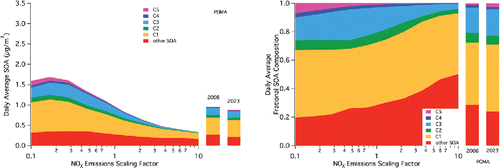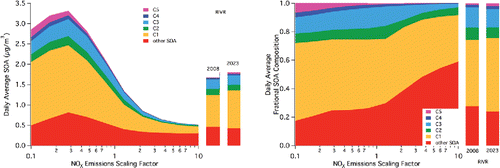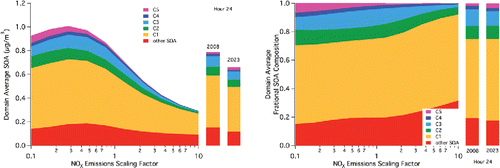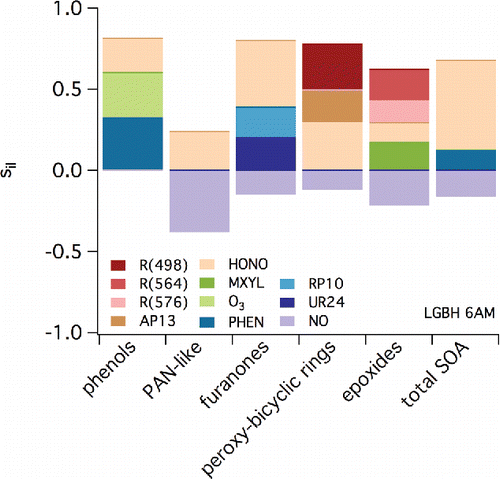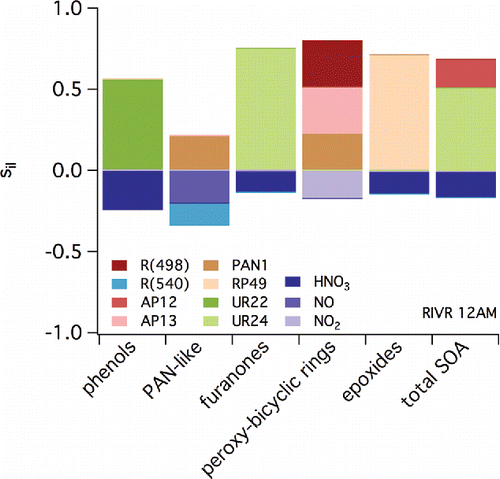Figures & data
Figure 1. Left: Domain-wide 24-h average (second model day) SOA concentrations as a function of NOx emissions scaling factors. Specified lumped SOA species C1–C5 represent newly added aromatic degradation products as described by Dawson et al. (Citation2016) (furanones, nitro-phenols, peroxy nitrates, epoxides, and peroxy-bicyclic rings, respectively). Other SOA encompasses all other SOA species from previous versions of CACM/MPMPO, including small amounts from monoaromatic species and all other VOCs. Bars on the right indicate base case 2008 and 2023 domain-wide 24-h average concentrations. Right: As in left but expressed as fraction of total domain-wide 24-h average SOA concentrations.

Figure 2. 24-h average (second model day) SOA concentrations and relative species contribution as a function of NOx emissions scaling factors in the grid cell for Central Los Angeles (CELA). Notation as in .
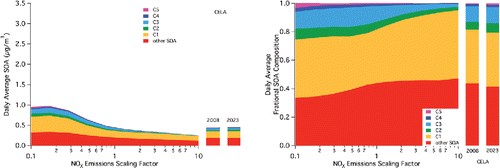
Figure 6. Comparison of changes in total daily emissions within the SoCAB between 2008 and 2023. Codes not defined elsewhere: CO (carbon monoxide), HCHO (formaldehyde), MEK (methyl ethyl ketone), KETO (higher ketones), BALD (benzaldehyde), PHEN (phenols), MGLY (methyl glyoxal), ALKL (short-chain alkanes), ALKM (medium-chain alkanes), ALKH (long-chain alkanes), ETHE (ethene), OLEL (short-chain alkenes), OLEH (long-chain alkenes), ISOP (isoprene), BIOL (low-SOA-yield monoterpenes), BIOH (high-SOA-yield monoterpenes), AROH (high-SOA-yield monoaromatics), AROL (low-SOA-yield monoaromatics), MEOH (methanol), ALD2 (higher aldehydes), SO2 (sulfur dioxide), SO3 (sulfur trioxide), HONO (nitrous acid), MCR (methacrolein), and ACID (carboxylic acids).
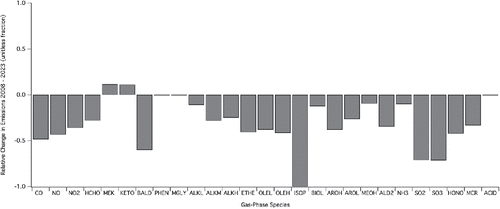
Figure 7. Relative contributions of various parameters (indicated by the shading) to overall sensitivity of SOA constituents and total SOA (listed along the x-axis) based on LHS output for conditions at 2:00 PM local time in CELA (Central Los Angeles). Only those sensitivities with an absolute value greater than 0.1 are shown.


